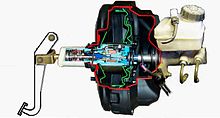| This article needs additional citations for verification. Please help improve this article by adding citations to reliable sources. Unsourced material may be challenged and removed. Find sources: "Vacuum servo" – news · newspapers · books · scholar · JSTOR (February 2017) (Learn how and when to remove this message) |


A vacuum servo is a component used on motor vehicles in their braking system, to provide assistance to the driver by decreasing the braking effort. In the US it is commonly called a brake booster.
A vacuum servo, also known as a power booster or power brake unit, uses a vacuum, usually supplied by the engine, to multiply the driver's pedal effort and apply that effort to the master cylinder.
Because the servo depends on the vacuum supplied by a running engine, a check valve is typically used in the vacuum line to maintain residual vacuum without engine support, allowing limited use even after parking.
See also
Notes
- "Brakes - Hydraulic - EduMech". www.edumech.co.uk. Archived from the original on 2016-04-25. Retrieved 2016-04-25.
External links
- What is a brake booster?
- "How Power Brakes Work", (a 4-page basic tutorial article, with illustrations & animation) at HowStuffWorks.com
| Automotive design | |||||||||||||
|---|---|---|---|---|---|---|---|---|---|---|---|---|---|
| Part of a series of articles on cars | |||||||||||||
| Body |
| ||||||||||||
| Exterior equipment |
| ||||||||||||
This article about an automotive part or component is a stub. You can help Misplaced Pages by expanding it. |